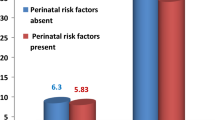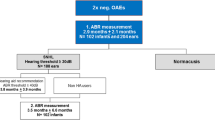Abstract
Purpose
Despite the recent trend of cochlear implantation (CI) at the age of six or even four months is prevalent in many centers around the world, clinicians should be cautious because perinatal risk factors of auditory neuropathy and/or delayed maturation carry the possibility of reversible hearing loss, yielding better auditory performance at the age of one year. The purpose of this study is to raise awareness that early CI may not be universal for all patients. In addition, we specify the factors to be considered in the pre-operative evaluation of CI in infants younger than one year.
Methods and results
This study describes four cases provisionally diagnosed with severe to profound sensorineural hearing loss that were presented to the CI clinic to determine candidacy for implantation. Two cases had histories of prematurity, one had Down syndrome, and one had a family history of hearing loss. None of the study cases were candidates for CI, as they had varying degrees of hearing improvement.
Conclusion
Although early CI may yield better auditory performance, the final diagnosis should be made only after repeated subjective and objective measurements as well as family feedback on the child's auditory performance, especially in preterm children. Early auditory brainstem response (ABR) prior to the age of one year in children with cognitive, neurologic, or developmental comorbidities should be interpreted with caution, as ABR "alone" could not accurately represent the child's true hearing ability in this patient population.




Similar content being viewed by others
Data availability
The figures and table contain all the data necessary to support the findings. No additional data is available.
References
Wolfe J (2018) Cochlear implants: audiologic management and considerations for implantable hearing devices. Plural Publishing, San Diego
Dettman SJ, Dowell RC, Choo D et al (2016) Long-term communication outcomes for children receiving cochlear implants younger than 12 months: a multicenter study. Otol Neurotol 37:e82–e95
Evelyn C (2000) position statement: principles and guidelines for early hearing detection and intervention programs. Joint committee on infant hearing. 2000. Am. J. Audiol. 9:9–2
Attias J, Raveh E (2007) Transient deafness in young candidates for cochlear implants. Audiol Neurotol 12:325–333
Coenraad S, Goedegebure A, Hoeve LJ (2011) An initial overestimation of sensorineural hearing loss in NICU infants after failure on neonatal hearing screening. Int J Pediatr Otorhinolaryngol 75:159–162
Hof JR, Stokroos RJ, Wix E et al (2013) Auditory maturation in premature infants: a potential pitfall for early cochlear implantation. Laryngoscope 123:2013–2018
Psarommatis I, Florou V, Fragkos M et al (2011) Reversible auditory brainstem responses screening failures in high-risk neonates. Eur Arch Otorhinolaryngol 268:189–196
Wunderlich JL, Cone-Wesson BK (2006) Maturation of CAEP in infants and children: a review. Hear Res 212:212–223
Jiang ZD, Wu YY, Liu XY (1990) Early development of brainstem auditory evoked potentials in Down’s syndrome. Early Hum Dev 23:41–51
Vinodh M, Ambikapathy P, Aravind MA et al (2014) Reversibility of brainstem evoked response audiometry abnormalities at 3 months in term newborns with hyperbilirubinemia. Indian Pediatr 51:134–135
Agrawal VK, Shukla R, Misra PK et al (1998) Brainstem auditory evoked response in newborns with hyperbilirubinemia. Indian Pediatr 35:513–518
Tanaka Y, Kaga K (1980) Application of brain stem response in brain-injured children. Brain Dev 2:45–56
Intrapiromkul J, Aygun N, Tunkel DE et al (2012) Inner ear anomalies seen on CT images in people with Down syndrome. Pediatr Radiol 42:1449–1455
Folsom RC, Widen JE, Wilson WR (1983) Auditory brain-stem responses in infants with Down’s syndrome. Arch Otolaryngol 109:607–610
Squires N, Ollo C, Jordan R (1986) Auditory brain stem responses in the mentally retarded: audiometric correlates. Ear Hear 7:83–92
Forti S, Amadeo C, Fagnani E et al (2008) Auditory brainstem responses (ABR) in normal hearing adult subjects with Down’s syndrome. Brain Res 1233:58–62
Rusu SI, Borst JGG (2011) Developmental changes in intrinsic excitability of principal neurons in the rat medial nucleus of the trapezoid body. Dev Neurobiol 71:284–295
Taschenberger H, von Gersdorff H (2000) Fine-tuning an auditory synapse for speed and fidelity: developmental changes in presynaptic waveform, EPSC kinetics, and synaptic plasticity. J Neurosci 20:9162–9173
Crins TTH, Rusu SI, Rodríguez-Contreras A et al (2011) Developmental changes in short-term plasticity at the rat calyx of Held synapse. J Neurosci 31:11706–11717
Jiang ZD (1995) Maturation of the auditory brainstem in low risk-preterm infants: a comparison with age-matched full-term infants up to 6 years. Early Hum Dev 42:49–65
Funding
This study was not funded by any governmental or private sponsor.
Author information
Authors and Affiliations
Contributions
MMM, YAEl-K: contributed in study design, data collection and analysis in addition to manuscript writing and revision of the manuscript.
Corresponding author
Ethics declarations
Conflict of interest
The authors declare no conflicts of interest or any commercial relation with the contents of the manuscript.
Ethical approval
A retrospective study where parents of the children have given their written informed consent. The Otolaryngology Department Board ethically approved the study.
Additional information
Publisher's Note
Springer Nature remains neutral with regard to jurisdictional claims in published maps and institutional affiliations.
Rights and permissions
Springer Nature or its licensor (e.g. a society or other partner) holds exclusive rights to this article under a publishing agreement with the author(s) or other rightsholder(s); author self-archiving of the accepted manuscript version of this article is solely governed by the terms of such publishing agreement and applicable law.
About this article
Cite this article
Mahrous, M.M., El-Khattib, Y.A. The challenge of a mature final diagnosis of hearing loss severity and early cochlear implantation. Eur Arch Otorhinolaryngol 281, 2011–2022 (2024). https://doi.org/10.1007/s00405-023-08439-2
Received:
Accepted:
Published:
Issue Date:
DOI: https://doi.org/10.1007/s00405-023-08439-2




